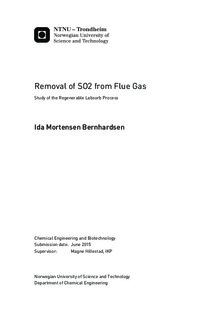Removal of SO2 from Flue Gas - Study of the Regenerable Labsorb Process
Master thesis
Permanent lenke
http://hdl.handle.net/11250/2351690Utgivelsesdato
2015Metadata
Vis full innførselSamlinger
Sammendrag
Sulphur dioxide (SO2) is a well-known air pollutant, and is primarily formed as a by-product when fossil fuels are burned at power plants. Due to stringent emission regulations, well-designed and efficient flue gas desulphurization technologies (FGD) are a necessity. One potential FGD technology is the regenerable Labsorb process. However, the process is little applied and limited information is available in the literature from plants, which have installed the process in full scale, pilot scale tests and laboratory studies.
This thesis seeks to find an electrolyte Non-Random Two Liquid (eNRTL) thermodynamic model in ASPEN Plus that is able to represent the experimental vapour-liquid equilibrium (VLE) data of the sodium-phosphate-water-SO2-system. Thereafter, the model will be used to identify energy efficient operating conditions in the Labsorb process.
In the work to find a suitable eNRTL-model, binary interaction parameters were fitted to VLE data. Absorption and regeneration of SO2 in the Labsorb process were simulated separately in ASPEN Plus. The Buffer 3/1/0.5, i.e. CNa2HPO4= 3 mol/L, CNaH2PO4= 1 mol/L and CNa2SO4= 0.5 mol/L was used as a solvent in the simulations.
In this work, it was developed an eNRTL model with an average deviation of 16.8% from experimental VLE data. The model was found to be valid in the temperature range 40 °C to 70 °C and in the SO2 concentration range 0.5 molSO2/L to 1.6 molSO2/L for buffer 3/1/0.5. Furthermore, it was shown that the method used to improve VLE in ASPEN Plus works. When absorption of SO2 was simulated, it was found that the absorption most likely was too ideal as it showed some deviation from available operating data. When regeneration of SO2 was simulated, it was not possible to conclude which operating conditions were most energy efficient. The main challenge in the study was lack of experimental data.
